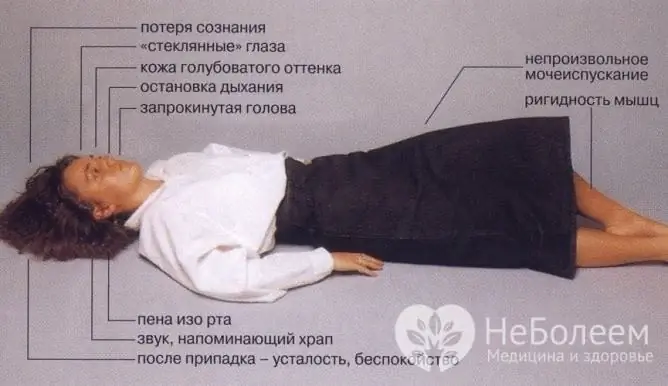- Author Rachel Wainwright [email protected].
- Public 2024-01-15 19:51.
- Last modified 2025-11-02 20:14.
First aid for epilepsy
The content of the article:
- How does an epileptic seizure manifest
- Epileptic seizure emergency care
- What is epilepsy
- Video
Every adult should know the rules of first aid for epilepsy. Indeed, at present, epilepsy ranks third in the overall structure of neurological diseases, second only to strokes and Alzheimer's disease. Let's take a look at what a seizure looks like, how to provide assistance correctly, and also talk about what not to do.

It is necessary to be able to recognize an epileptic seizure
How does an epileptic seizure manifest
During a generalized seizure, several phases can be distinguished:
| Phase | Description |
| Aura | In many cases, the development of an epileptic seizure is preceded by an aura (visual, olfactory, or auditory hallucinations, involuntary head movements, discomfort in the epigastric region). But since its manifestations are invisible, it seems to others that the attack occurs suddenly. |
| The beginning of the attack | The sick person makes a loud groan or scream, loses consciousness and falls. |
| Tonic convulsions | Lasts 2 to 30 seconds. The muscles are tense, the legs are straightened, the arms are bent at the elbow joints. Due to respiratory arrest, cyanosis of the skin of the face and neck develops. |
| Clonic seizures |
Lasts 1-3 minutes. Muscles involuntarily tense and relax, which is perceived by others as twitching. Breathing becomes noisy. Foam appears from the mouth, often colored pink or red due to biting the tongue and cheeks. Involuntary urination and defecation are possible. |
| Ending | After the seizure has ceased, patients in most cases fall asleep. In the future, they do not remember what happened. If the patient does not fall asleep, then for some time he is in a twilight state of consciousness. He can walk, make any automatic movements, without realizing his actions. |
Epileptic seizure emergency care
A seizure in epilepsy looks intimidating, but in fact, in most cases, it does not require urgent medical attention. But to prevent the development of injuries in a patient, to know how to alleviate his condition and when to call an ambulance, it is necessary for every person.
The algorithm of actions for an epileptic seizure is as follows:
- Before proceeding with first aid, make sure you are calm and not panicky. Otherwise, you can involuntarily make a mistake, harm the patient.
- Do not leave the patient alone during an attack. After its completion, make sure that the person has fully regained consciousness, and gives a full account of his further actions.
- During a seizure attack, the patient should not be moved from place to place. Move furniture or other objects away from it that could bump into. If this is not possible, place blankets, pillows, soft bags between the pieces of furniture and the sick person.
- Note the time when the seizure starts.
- Do not try to forcefully restrain the patient, as this can lead to injury.
- Do not put anything in the patient's mouth. At the time of convulsions, tongue retraction does not occur, and when hard objects are inserted into the mouth, there is a high probability of damage to the patient's teeth, in addition, attempts to open his mouth with his hands often end in deep bites on the fingers of the person providing first aid for an epilepsy attack.
- Track your time. If the seizure lasts more than 5 minutes, be sure to call your doctor. With a long-term seizure, there is a high likelihood of developing hypoxic brain damage. If, after providing first aid (PMP), the attack cannot be stopped or the patient continues to remain unconscious, he is hospitalized in a neurological hospital.
- After the seizure stops, help the person to get into a comfortable position. The most correct way would be to turn it to one side and place a small pillow under your head.
- Make sure the patient is breathing freely. If necessary, clean the oral cavity from the accumulated saliva, vomit. If shortness of breath persists, then urgently call a doctor.
What is epilepsy
Epilepsy is a chronic brain disorder that is characterized by recurrent seizures.
The pathological mechanism of the onset of the disease is based on the excessive production of electrical impulses by individual groups of nerve cells (neurons). If the focus of pathological excitability is small, then the patient develops small seizures. Sometimes they are invisible to others, and in this case they talk about the latent course of epilepsy.
In cases where the pathological focus is large enough, it transmits impulses to the entire cerebral cortex, from where they reach the muscles along the nerve fibers, causing them to contract. This phenomenon is called an electrical storm. Clinically, it manifests itself as a typical generalized convulsive seizure. With the development of such a seizure, people who are next to him usually come to help the patient first.

An epileptic seizure can occur at any time
The exact causes of epilepsy are currently not known. Contributing factors can be:
- metabolic disorders;
- cerebrovascular disease;
- volumetric processes in the brain;
- congenital cerebral anomalies;
- traumatic brain injury;
- hypoxia and asphyxia;
- central nervous system infections;
- poisoning with toxic substances or drugs;
- anaphylactic reactions;
- withdrawal symptoms;
- hyperpyrexia.
Epilepsy can affect people of any age, but most often the onset of the disease occurs in children and the elderly.
The factors that trigger the development of seizures in patients with epilepsy are:
- refusal of anticonvulsant therapy;
- abuse of antidepressants;
- changes in hormonal levels;
- lack of sleep;
- smoking;
- drinking alcoholic beverages;
- stress.
Video
We offer for viewing a video on the topic of the article.

Elena Minkina Doctor anesthesiologist-resuscitator About the author
Education: graduated from the Tashkent State Medical Institute, specializing in general medicine in 1991. Repeatedly passed refresher courses.
Work experience: anesthesiologist-resuscitator of the city maternity complex, resuscitator of the hemodialysis department.
Found a mistake in the text? Select it and press Ctrl + Enter.






